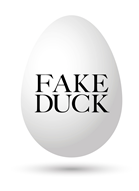Imagine you file an application for a figurative mark, and EUIPO publishes it. But then your application is opposed by a third party. So while you’re fighting that battle, you file just the word portion of your figurative mark and get a registration. You also file, two further figurative marks containing the same word mark, but while one is published (and is later opposed), the other get refused by EUIPO.
Confusing, isn’t it? But – unfortunately – a story taken from real life:
Itinerant Showroom Srl, (Itinerant) has registered and applied for a series of trademarks consisting of or containing the expression “FAKE DUCK”, inter alia for apparel in class 25. The very first, EUTM application no. 15912496, filed on October 11, 2016, as now shown on the left, was opposed based on the mark shown on the right.


Back in July 2020, in the case T‑371/19 (commented here), the General Court (GC) held that EUIPO had been correct in finding a likelihood of confusion between FAKE DUCK and SAVE THE DUCK.
On April 23, 2018, Itinerant applied for FAKEDUCK (wordmark) and obtained EUTM registration no. 017891138.
Finally, on August 23, 2018, Itinerant filed further two EUTM applications: no. 17946881 for FAKE DUCK in a broken eggshell (below, left) and no. 17946879 for FAKE DUCK inside a whole egg (below, right).


The broken egg version was published and subsequently opposed – the opposition is still pending. The whole egg, however, was refused by EUIPO and the refusal upheld by the Boards of Appeal. The argument was, in short, that the clothing concerned by the trademark might potentially contain a filling with an imitation of duck feathers, and that the representation of the egg only reinforced the semantic content of the term FAKE DUCK, without adding distinctiveness.
Fast-forward to October 15, 2020, when the GC in case T‑607/19, just 3 months after its previous FAKE DUCK decision in T-371/19, had to rule on whether this was correct.
Itinerant, in its appeal to the GC, claimed violation of the principles of legality and equal treatment. The GC, blissfully indifferent to its own earlier analysis carried out in case T‑371/19, dismissed Itinerant’s appeal, citing once again the case law according to which the principle of equal treatment cannot override the legal principles enshrined in the grounds for refusal.
Interestingly enough, in the decision B 003073862 taken on 20 March 2020 in the opposition against the broken egg version , EUIPO held instead that the expression FAKE DUCK and the image of an egg were not directly descriptive, allusive or otherwise weak. That decision was appealed.
, EUIPO held instead that the expression FAKE DUCK and the image of an egg were not directly descriptive, allusive or otherwise weak. That decision was appealed.
So summing up: the word mark FAKEDUCK is registrable. A figurative mark containing the image of a duck and the words FAKE DUCK is confusingly similar to another mark with another image of a duck and the words “SAVE THE DUCK”. An image of a broken egg with the words FAKE DUCK inside is registrable but again confusingly similar to the SAVE THE DUCK mark. And an image of a whole egg with the words FAKE DUCK on it is completely descriptive?
The difference between the absolute grounds decisions and those on the oppositions is that, for the FAKE DUCK mark to be refused as descriptive, it is enough if it will be understood anywhere in the EU. That is of course easy – every English speaker will understand this. On the other hand, for the oppositions to be successful, it is enough if DUCK is not understood anywhere in the EU. This is an inbuilt oxymoron in EUTM law with which practitioners and trademark owners continue to have problems.
And of course this does not explain the contradiction between accepting the word mark while refusing the figurative mark, which simply shows that examiners may not technically but do in fact have a lot of room for discretion.
So are we all less confused?
_____________________________
To make sure you do not miss out on regular updates from the Kluwer Trademark Blog, please subscribe here.



Thank you for an interesting (and entertaining) article.
You say (second last paragraph): “On the other hand, for the oppositions to be successful, it is enough if DUCK is not understood anywhere in the EU.”
Could you kindly let me know the legal basis for that rule under EU trademark law (EUTMR), if any?
Thank you.
Best regards.